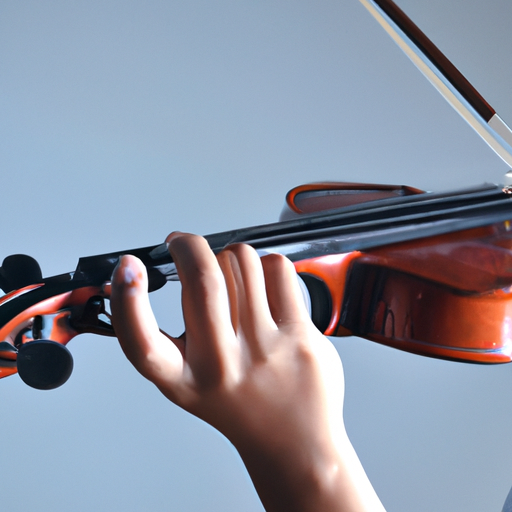
When learning to play the violin, one of the fundamental skills that every novice violinist must master is correct bow holding. Bow holding refers to the proper technique of holding and maneuvering the bow to produce the desired sound on the instrument. It is an essential aspect of violin playing that greatly affects the quality of sound and overall performance.

Correct bow holding may seem like a simple concept, but it requires precision and practice to achieve. Novice violinists often make mistakes in their bow holding technique, which can hinder their progress and affect their ability to produce a beautiful tone. In this article, we will explore the anatomy of the bow, correct left hand placement, proper bow grip, bowing techniques, bow angle, pressure and speed, exercises for improving bow holding, and how to troubleshoot common mistakes.

Before diving into the specifics of correct bow holding, it is important to understand the various parts of the bow. The bow consists of the stick, frog, hair, and screw. The stick is the long, slender part of the bow that the violinist holds. The frog is the end of the bow that houses the mechanism for tightening and loosening the hair. The hair is made from horsehair and is stretched from the frog to the tip of the bow. The screw is used to adjust the tension of the hair.
To hold the bow correctly, the violinist should position their hand on the stick between the frog and the winding. The thumb should be placed on the inside of the frog, and the fingers should gently wrap around the stick. The pinky finger should rest on top of the stick, providing stability and control.
The left hand and the bow hand work together to produce the desired sound on the violin. The left hand is responsible for fingering the notes on the fingerboard, while the bow hand controls the bowing technique. It is crucial to have correct left hand placement to support and complement the bow hand.
Proper left hand placement involves positioning the fingers on the fingerboard in a relaxed and rounded manner. The thumb should be placed opposite the second finger, and the fingers should be curved and spaced evenly. This allows for accurate finger placement and efficient execution of different techniques on the violin.
There are different types of bow grips, each with its own advantages and disadvantages. The most common bow grips are the Russian grip, the Franco-Belgian grip, and the German grip. The Russian grip involves resting the bow on the side of the index finger, providing stability and control. The Franco-Belgian grip places the bow between the first and second joints of the index finger, allowing for flexibility and agility. The German grip positions the bow on the pads of the fingers, providing a balanced and relaxed grip.
Regardless of the type of bow grip, the key is to achieve a proper bow grip that allows for control, flexibility, and a good sound production. The grip should feel comfortable and natural, and the fingers should be able to move freely while maintaining a steady hold on the bow.
Proper bowing techniques are essential for producing a beautiful tone and expressive playing on the violin. Novice violinists should focus on mastering the basic bowing techniques before moving on to more advanced techniques. Some common bowing techniques for novice violinists include the whole bow stroke, the half bow stroke, the spiccato stroke, and the staccato stroke.
The whole bow stroke involves drawing the bow from frog to tip in a smooth and continuous motion. The half bow stroke covers half the length of the bow, requiring control and precision. The spiccato stroke produces a bouncing motion on the strings, creating a lively and energetic sound. The staccato stroke consists of short, detached notes that add rhythmic interest to the music.
The bow angle refers to the angle at which the bow is placed on the strings. It is important to maintain a proper bow angle to produce the desired sound and avoid unwanted noise. The bow should be held perpendicular to the strings, with the hair making full contact with the strings.
To achieve a proper bow angle, the violinist should ensure that the bow is neither too tilted nor too flat on the strings. Practice exercises such as bowing on open strings and playing scales can help develop a sense of bow angle and control.
Pressure and speed play a crucial role in bowing techniques and sound production on the violin. The amount of pressure applied to the strings and the speed at which the bow is moved affect the dynamics and tonal quality of the sound.
For different playing styles, such as playing softly or loudly, the violinist must adjust the pressure and speed accordingly. Lighter pressure and slower bow speed produce a softer sound, while firmer pressure and faster bow speed create a louder and more powerful sound. It is important to experiment with different levels of pressure and speed to achieve the desired musical expression.
To improve bow holding, regular practice is essential. There are various exercises that can help develop proper bow holding technique. One exercise involves practicing bow grips and changing between different grips to improve flexibility and control. Another exercise is bowing on open strings while focusing on maintaining a consistent sound and bow angle.
It is important to incorporate these exercises into daily practice routines to build muscle memory and reinforce correct bow holding habits.
Novice violinists often make common mistakes in their bow holding technique. Some of these mistakes include gripping the bow too tight, collapsing the wrist, using excessive arm movement, and inconsistent bow angle. These mistakes can lead to a poor sound quality and hinder progress.
To troubleshoot and correct these mistakes, it is important to be mindful of the hand and arm position, practice with a mirror to observe any incorrect movements, and seek guidance from a qualified violin teacher or mentor. Regular self-assessment and feedback from others can help identify and address any issues in bow holding technique.
In conclusion, correct bow holding is a fundamental skill that every novice violinist must master to improve their playing ability. It involves understanding the anatomy of the bow, achieving proper left hand placement, developing a proper bow grip, mastering bowing techniques, maintaining a proper bow angle, and adjusting pressure and speed for different playing styles.
Regular practice, incorporating exercises specifically designed to improve bow holding, and troubleshooting common mistakes are crucial for developing and maintaining correct bow holding technique. With dedication and patience, novice violinists can achieve a beautiful tone and expressiveness in their playing, setting a solid foundation for their musical journey.
For more information about correct bow holding for novice violinists, visit https://bannhacflamenco.net/cho-thue-ban-nhac/luom-lat-tin-do-day/.